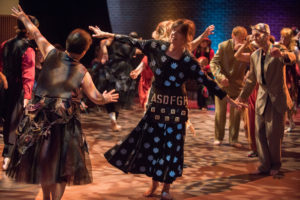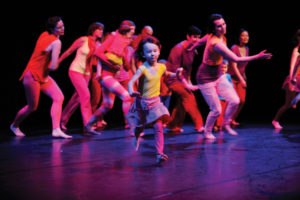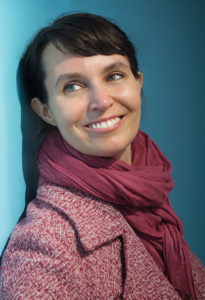Dance for Every Body: Engaging communities and making Vancouver move - Vancouver Ballet Society
- Home
- Features 2015 - 2019
- Dance for Every Body: Engaging communities and making Vancouver move

by Hilary Maxwell
Everybody can dance. This notion lies at the heart of community-engaged dance, where diversity and inclusivity are embraced, and the artistic process is shared between professional dance artists and community members. For several Vancouver dancemakers, working in community contexts plays an essential role in their practice.
In the early 1990s, when community-engaged dance was beginning to take hold on the west coast, the term did not even exist and there was little awareness about this type of work in the professional arena or among funding bodies. Nor was there the same kind of infrastructure in place to support community projects. Three choreographers who were significant in opening the conversation about where the borders of artistic practice lie are Judith Marcuse, Joe Laughlin and Karen Jamieson.

Photo: Chris Randle
In the booklet, Dancing our Stories (2005), City of Vancouver cultural planner Douglas D. Durand highlights the ways in which Marcuse, Laughlin and Jamieson were broadening the scope of their professional work to connect with people in what he refers to as dance animation — “developing new relationships between dance artists and diverse members of the community.” What interests Durand is the potential for dance animation to address social issues, develop community, stimulate creativity and build audiences.
Marcuse’s background in dance is rooted in classical ballet. Her résumé includes dancing with Les Grands Ballets Canadiens de Montréal and Ballet Rambert in England, and founding her own repertory company, Judith Marcuse Projects, in 1980. As she explains in Dancing our Stories, Marcuse developed an interest in expanding her choreographic exploration and, in the mid-1990s, she began a series of workshops that engaged large groups of youth to make dance that tackled social issues, hoping to tap into youth concerns in an authentic way. The first one, ICE: beyond cool, focused on teen suicide, and evolved into a three-year project of workshops, resulting in performances at home and on a national tour. It successfully built a broad community network through partnerships with various youth-centred organizations and service agencies.
Marcuse’s work with community eventually took her into a partnership with Simon Fraser University when, in 2007, she spearheaded the launch of the International Centre of Art for Social Change.
Laughlin, artistic director of contemporary dance company Joe Ink, established in 1995, came to community-based work after his experience in Johannesburg, where he collaborated with Moving into Dance Mophatong to create Sonke Sisonke / Every Body Dance (2002). While working with the South African company over a span of five years, Laughlin was introduced to their Edudance program, which offers a curriculum that teaches academic subjects to students through movement.
In 2001, Laughlin established Move It! in Vancouver, inspired by the positive impact dance can have within the community, and by the vibrant intergenerational culture of South Africa. Move It! continues to run free workshops for people of all ages, levels of experience and abilities, providing the opportunity for participants to learn basic dance steps and engage in a creative process. Facilitated now by members of the city’s contemporary dance scene, Move It! still harnesses the spirit of what first excited Laughlin to embark on the project — the idea that movement is an expressive tool to empower and elicit joy among participants.
Of the three, Jamieson has maintained the longest ongoing community dance practice, and is regarded today as a leader in this field, mentoring younger choreographers. Before venturing into the community arena, Jamieson had already developed a significant body of work as a modern dance choreographer and founded her company, Karen Jamieson Dance, in 1983. Today, Jamieson has built a rich practice that weaves her interests in staged choreography, site-specific performance, cross-cultural collaborations with First Nations artists and thinkers, and community engagement.

Photo: Chris Randle
Jamieson’s perspective around dancemaking and performance started to shift during the creation of Passage (1990), a commission by Ottawa’s National Gallery of Canada, which was developed and performed in the public spaces of the gallery. The company of seven dancers, including Jamieson, inhabited the building, jumping and spinning through the hallways, climbing up and down stairs, and rebounding off walls, all the while monitored by an army of guards whose job it was to protect the artworks. Over the seven-week residency, the guards naturally started to become almost part of the piece, guiding the public in and around the dancers to places where they could get the best vantage points. “They became an intermediary between the audience and the dance,” says Jamieson. After Passage, she felt inspired to continue exploring the interface of creative engagement between professionals and community.
One response to that vision is her work with residents of Vancouver’s Downtown Eastside, where poverty and homelessness is widespread, and issues of addiction and mental health are common. Believing that dance has the power to heal, Jamieson was drawn to engage with the people living in this area and, in the early 1990s, she ran her first dance workshop there as part of a University of British Columbia course called Humanities 101. In 2005, she established the Carnegie Dance Troupe through a partnership with the Carnegie Community Centre, offering a series of free creation workshops and performance processes to residents of the area, and has remained engaged with this group ever since.
The Carnegie Dance Troupe consists of non-professional and professional dancers, made up of a core group who have been working with Jamieson since the Humanities 101 days, and of people who come and go. The troupe operates with the mandate of absolute inclusivity. Pam Tagle, general manager of Karen Jamieson Dance, says, “If someone decides to participate a few days before a performance, Karen always finds a way for that person to be involved.”
Every workshop begins the same way, with a warm-up that brings the dancers’ awareness to their breath, to the weight of their body and its connection to the earth, and to the rebounding energy the earth gives back to the body. Often working in a circle, and never using mirrors, Jamieson guides the group through various forms of improvisation, encouraging them to experience the work from the inside, exploring movement that gives the dancers a sense of rooting to the ground. Creating with a focus on connecting to the earth gives the dancers a “greater ability to stand up in their own world,” says Jamieson.
At the end, the group will share what resonated, any problems they encountered and any ideas they want to contribute to the process. “After people have been moving for a while, they are much more relaxed. The fretting anxieties they may have come into the room with don’t colour the words that come out,” Jamieson says.
Jamieson believes dance is an embodiment of spirit and place, which inspired her first project with the Carnegie Dance Troupe. Stand Your Ground (2008), a travelling site-specific work, began with three years of workshops. “The act of creating something, working together toward an outcome, is empowering and builds a sense of belonging,” she says. The piece served as a vehicle to engage the performers, the audience and community residents, through a journey linking historical landmarks in the Downtown Eastside.
Jamieson does not view her professional and community work in a dichotomous relationship. Creative exploration in each arena, she says, “opens up my ideas of what dance is, how it functions and what its powers are.” She acknowledges that while there are profound differences in each, they are both grounded in a similar foundation of values where dance is empowering, develops a sense of identity and roots us to place.
Today, community-engaged dance is widely recognized as a relevant and beneficial practice that demonstrates how creative engagement is not limited to the professional artist. Collegiality among practitioners and the Vancouver Park Board’s commitment to develop community through arts and culture processes has a lot to do with the growth and awareness of this work in the city. Marie Lopes, arts programmer at the Roundhouse Community Centre in Vancouver, believes that “when there are people who want to talk about what you want to talk about, you find each other.” Leading from Beside, an 11-day celebration of community-engaged dance presented at the Roundhouse last fall, was an example of this coming together.

Photo: Chris Randle
Celebrating its 20th anniversary this year, the Roundhouse is a key player in community-engaged dance, providing opportunities for artists to experiment through its residency program. Lopes is interested in projects that stimulate the creative exchange of ideas, encourage risk-taking and nurture relationship-building among all involved. “What I look for is a realistic sense of what it means to work with non-artists,” says Lopes.
“I look for a sense of imagination that understands the significance of not approaching work in a discipline-based way,” she adds. In other words, the objective of this kind of work — be it dance or otherwise — is not merely a transactional process, in which the expert’s knowledge and skills are acquired by and developed in the non-expert. While that has a valid place in the world, she says, the goals here are to make work together and for shared ownership of the final creation.

Photo: Riz Herbosa
Such collaboration is integral to choreographer and facilitator Julie Lebel’s practice. Her company, Foolish Operations Ensemble, engages parents, caregivers, children aged four and under and professional artists in creative practice and performance. In a conversation with Lebel, I hear a resounding passion around drawing from the different skillsets, experiences and knowledge base of the participants in the artistic process. “You work with the material and skills you have in the room; some people might have a long background in dance and then maybe they decided to become a nurse, others might not have ever danced before, but practise karate or martial arts.” Lebel explains that looking to the diversity of expertise among participants is often a great starting point for choreographic exploration. While she might teach some skills to support the process, like improvisational techniques or ways to build choreographic structures, she stresses, “I am not coming in saying ‘Here’s how you dance, here’s how you create.’”
Lebel’s work Tricoter (meaning to knit) involved a group of children and adults, including some professional artists, and drew in audience members, too. Developed through an artist and community residency at the Roundhouse, the work re-creates the spirit of a knitting circle and questions how we build social fabric, using yarn as a way to explore ideas around connecting and belonging. At a performance of Tricoter on International Dance Day last April, the audience was arranged in an intimate circle, made up of small children, parents, passersby who were invited to sit in, and one woman who was deeply involved in knitting a scarf. We all sat closely side by side connected by a thick crimson strand of yarn that was placed on our laps. A little girl was asked to hold the end of another piece of vibrant wool, while Anne Cooper, an experienced professional dancer, leaped and twirled in the enclosed circle, with numerous balls of multi-coloured yarn strewn about. Cooper’s body cut through the space and the material like knitting needles, knotting and unraveling herself and the wool. Two other spectators were asked to catch balls of yarn. Together we all shaped and became the dance.
“There has been more recognition that ‘high art’ practice doesn’t necessarily engage with everyone in a way that is accessible,” says Naomi Brand, artistic director of All Bodies Dance Project. Brand and her co-director Sarah Lapp, who is a dancer, wheelchair user and advocate in the disability community, are committed to removing barriers that exclude participation. These include high costs, locations that have spaces with stairs, that don’t have wheelchair-accessible washrooms or are not accessible by transit, and elitist attitudes about what kind of bodies can dance.
Brand, with a background in contemporary dance and contact improvisation, has worked for many years as an interpreter and choreographer. Like Lebel and Jamieson, her creative practice draws on the differences of the people in the room as a creative strength. She is interested in the tension between the individual and the group, and in spatial design. Brand sees All Bodies as a meeting ground for creative engagement, where each member brings something to the table, and her role is to guide that process while also being a part of it. “I’m actively being challenged by the practice. By interpreting and translating movement that is created by a seated dancer or a dancer who perceives differently than me, I’m learning new ways to move that my typical dance training never presented,” she says.
All Bodies engages with more than 100 participants in a season, running several free sessions a week, and provides performance opportunities to its core group of 20. Dancers range in age from 16 to 65, are of all genders and include those with both visible and invisible disabilities. There are manual and power wheelchair users, folks who use crutches and other mobility aids, and standing dancers.

Photo: Courtesy of All Bodies Dance Project
Brand, who leads the majority of the classes, begins by inviting everyone to join in a circle, and asks the participants to say their name and their preferred pronoun, and to tell the group what they need to know about themselves in order to dance with them that day. “Nobody is asked about their disabilities. It’s not relevant to the practice.” She then leads the group through a warm-up with movements that help develop a sense of body awareness. Brand uses a lot of imagery, sensation and touch as a way for people to get into their bodies, as opposed to instructing with specific exercises or set pathways. The dancers travel through the space, in and around one another, in straight lines and curved lines, coming close together and moving far away. “Moving in space is an important part of what we do because people need to develop their awareness to work with bodies different from theirs, and in different ways,” explains Brand.
All Bodies Dance Project was recently awarded with a Canada Council for the Arts New Chapter grant, intended to honour Canada’s 150th anniversary, which will provide substantial financial support in the realization of an innovative project about the aesthetics of accessibility. The project, titled Translations, will be developed in collaboration with VocalEye, a live audio description service for people with vision loss that works with arts theatre organizations to support the accessibility of their productions.
VocalEye provided audio description for dance for the first time at Do Make Show, an All Bodies mixed bill presented last June at the Roundhouse. “How do we hear what dance looks like?” asked Brand at the pre-show introduction. Some audience members had the chance to experience just that, wearing a headset that played back a description of each piece while it was performed, as told or interpreted by a “describer.” VocalEye’s director Steph Kirkland explains the describers don’t attempt to tell an all-encompassing narrative of the performance. “It might be more useful for us to think in terms of conveying a dream, rather than telling a story, told through a series of scenes or images or actions that may or may not be related to what comes next,” she notes. “There’s no plot, but something unseen propels us forward.”
For Translations, All Bodies will tackle how dance can be experienced not only visually and through live audio description, but also through “tactile” description; the latter refers to a system of lines, patterns and rhythms “drawn” on a surface of a spectator’s body by a describer’s fingers, which evoke the dance.
All Bodies Dance Project was conceived with the goal to open the boundaries of who can participate in the act of dancing and, now, who can witness it. The Canada Council’s support of this experimental, research-based community-engaged dance project reflects how ideas of excellence and the role of art itself are changing; we seem to be in a moment where a shift is happening. But is it truly possible to view dance, a visual and kinesthetic art form, through hearing and touch? Brand and her team are going to try and find out. “It’s an ambitious project,” she says, “but we’re driven to discover ways for dance to be experienced and presented that is inviting to everyone and every body.”
DI WINTER 2017

Photo: Erik Zennström
